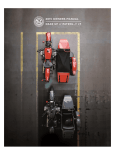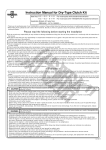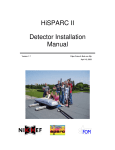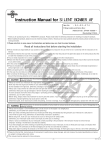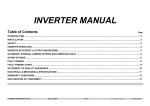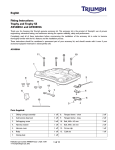Download Sidestand Safety Switch Rewiring 2.1
Transcript
Side-stand Safety Switch Electrical Rewiring By Fariborz Rostami Menlo Park, California (Revision 2.1, February 21, 2002) Legal Disclaimer: Do not attempt to perform the modification described in this document in any shape or form. Modifying your Side-stand safety switch can have severe consequences, including death caused by riders riding off while their side-stand is down. This is not an instruction manual. If you decide to modify your side-stand safety wiring you will be fully responsible for any damages or injuries caused by your modification to you , your property, or anyone else and their property. By reading the remainder of this document, you acknowledge that you have read and understood and agreed with this legal disclaimer, and will not hold the author of this document responsible for a) any personal injuries to yourself or any other person and b) for any property damages, as the result of any side-stand safety switch wiring modifications attempted or instructed by you. Why did I modify my side-stand safety switch? The first time I tried to start my ST4 was at the dealer where I eventually bought my bike. I wanted to take the ST4 for a test drive. The salesperson gave me the key. I checked, and everything looked fine. Trying to start the bike nothing happened. Not even a sound that something was trying to happen. I felt like a fool standing next to the bike and not having a clue of what was going on or what to do next. The ignition lights were all on, the neutral light was green, the emergency cutoff switch was in the run position but nothing was transpiring when I pressed the start button! Having been riding for years, I could not even get the damn thing started at the dealer (how embarrassing). This is after I told the salesman, "Yes I own another Ducati (a Monster) and I know everything there is to know about Ducatis". Looking at the salesman’s face, it was like listening to a loudspeaker of what was going on in his head. His lips were not moving, you could not hear any sound but his voice was deafening: "This bozo is just trying to go for a test drive?" "He will probably crash the damn thing in the first corner." "He probably has not been on a bike before, I am not even sure if his motorcycle driver license is real, I should take a look at that thing again." Trying to show me what an idiot I was, he kind of nudged me aside and said "let me start it for you, SIR". By this time I was sweating. I passed him the key and stood to the side, waiting for his next "you idiot" joke after he started the bike. To my surprise, he could not get the damn thing started either. By this time my embarrassing cold sweat was drying into "and you work here at a motorcycle dealer" look. He was turning the ignition key back and forth, pushing the gear lever, pulling in the clutch but nothing, I mean nothing, was happening. He decided to go inside to talk to the mechanic or whomever he could find in the shop. Not having anything to do, I opened the USER MANUAL. Here it was under "Starting the engine" section: Warning: The side-stand must be fully up (in a horizontal position) as its safety sensor prevents engine start, when down. At least it was documented. This time I sat on the bike, kicked up the side-stand, pushed the starter, and the bike started right up. By this time I could see the salesman at the backend of the store coming toward the street, with one of those "I still do not have clue" looks. Granted, this was a used Ducati at a Honda/Suzuki dealer and these guys did not know anything about Ducatis, but you would expect they should have at least known how to start the bike. Anyway to make the story short, as you can see by now I ended up buying the bike. At the time that I bought the bike, I did not think too much about the sidestand switch. I thought, it is one of those things, it is probably there for a good reason. As weeks and then months went by, this side-stand safety switch started to get under my skin and it got under my skin badly. Trying to warm up the bike, I had to put the bike on the center-stand, which is not the easiest thing in the world either. Even today after having owned the bike for almost 4 months, I still have to rock the bike four to five times to get it on the center-stand (damn, I hate that). I also think pulling such a heavy bike up on the center stand has kind of put some pressure on the pannier left-hand side bracket (it is not that heavy duty) and has slightly bent it. I had a tough time aligning the bracket with the holes when I removed the bracket for some other maintenance work. On my Monster I had a retractable side-stand (stand would retract once you straightened the bike) that I originally hated. I eventually got to like the retractable side-stand a lot, after the initial "what the heck is that" impression. Although Monster's retractable side-stand had its own issues I still liked it. But I never got used to the ST4’s side-stand safety switch operation. It was time to do something about this. I started researching this issue and found some very useful stuff at Bob Cowin's Ducati Index under "Tech Tip" section. What I ended up incorporating on my bike and later documenting here, is a more detailed version of what was described at the Ducati Index's "Useful Tip" section. By the way, there was no Legal Disclaimer there (how irresponsible and inconsiderate of people)! Solution Description: The main goal is to rewire the side-stand safety switch so that the bike starts while on the side-stand and in Neutral. Additionally: 1) If the bike is not in neutral, the engine will not start. 2) If the bike is in neutral and the engine is running, putting the bike in gear while the side-stand is down will kill the engine. 3) If the bike is in neutral and the engine is running, putting the bike in gear while the side-stand is up will have no effect and the engine will keep on running. I really think this is the way the safety switch circuitry should have been designed in the first place. This will keep the original intent of not allowing the rider take off while the side-stand is down and it will also allow people to warm up the engine while the bike is on the side-stand. May be Ducati thinks their bikes can get into gear by themselves! What if that is true!? I think I should stop writing and go back to the garage and undo the wiring back to the stock setup. No, no and no. I cannot go back to the stock setup. It is going to drive me mad in no time if I do that. So I keep on writing. By the way Evoluzione sells a solution similar to what is described in this document for a lot of different model Ducatis, including ST4. Their kickstand/starter bypass harness function-wise is almost identical to what is described here and it sells for $40, plus shipping. You can see their product by clicking here. Considering what one gets, even at $40, it is not a bad price. It will save some time (therefore money) using a pre-fabricated part versus shopping for parts, soldering them and fabricating the bypass wire. People who like the functionality described in this document and are sick of how their bikes side-stand switch works in stock form should call these guys. I hear that Ken Zeller, the owner of Evoluzione, is also hell of a nice guy. But I am an motorcyle enthusiast and a home mechanic junkie, what can I say. There is a level of satisfaction that I get when I work with my hands and when I build things. It is hard to explain that feeling, unless you enjoy doing the same type of thing. You know it is like telling someone how much fun it is to ride a Motorcycle. Unless they have tried it, they will not fully understand what you are talking about. My dog likes to stick his head out of the window of the car at 65 MPH. When wind joggles his lips like a flag in the wind, he looks like he is laughing hard and is having hell of a great time. His ears are pushed to the back of his head by the wind. I tell my wife, he knows why I like riding! Other people have tried other solutions (i.e. grinding down the tab close to the side-stand mounting bolt) that allows the rider to start the engine on the side-stand. But that solution will not kill the engine if the bike is put into gear. I am getting old and I think of safety issues in my old days, especially if it related to my motorcycle. With the Mission goal in hand and copy of a note from the Tech Tip section of Ducati Index, I went shopping. The only money I really needed was the left over change in my pocket. Here is why. Parts Needed: To rewire the side-stand safety switch, I needed the following parts: 1) One, Silicon Diode 1N4001 I purchased these from RadioShack for $0.59. The package included two, but I only needed one for the rewiring. 2) Two inline T branch Connectors I purchased them at Fry's Electronics for $1.49 for a package of 5. These allow you to branch off a wire without having to cut the wire in half. 3) Some electrical wire I had a spool of 18-gauge wire in the garage that I used approximately 2.5 feet (70-80 cm) of. 4) Some electrical tape or heat shrink tubing. Mental Note to self: If the wife asks how much all of these stuff costs, for once tell her the TRUTH, and nothing but the truth. Even show her the receipts. Installation: The first step was to incorporate the diode into the wire that was going to go between the neutral switch wire and the side-stand safety switch wire. The purpose of this diode is to allow the power to go in one direction only. If that is not done, the neutral light will stay on at all times when the side-stand is up, even if the bike is in gear. The diode is direction sensitive. There is a stripe on one end of the diode. I needed to make sure that the stripe was on the neutral switch side and not the side-stand safety switch side. To do this I cut the wire about 5 inches (12 cm) from one side. This was going to be the neutral switch side. I soldered the diode inline making sure that I kept the diode in the right orientation. After soldering the diode, I placed a 1/8" heat shrink tubing on the exposed area of the wire and heated the tubing to insulate the exposed wires. I later moved one layer of heat shrink tubing on the whole wire for extra protection. To be able to tap into the Neutral signal, I needed to locate the Neutral Switch on the bike. On my ST4 the neutral switch is located on the right hand side of the bike, in the rear of the engine close to the rear shock. I am guessing on the St2 the neutral switch is in a similar location. The neutral switch operates with a single wire. It uses the chassis for ground. When the bike is in neutral it grounds the signal coming from the neutral light bulb in the light cluster above the dash panel. This causes the current to go through the bulb and therefore turns it on. To tap to the wire that goes into the neutral switch, I first removed the connector from the switch. I then used one of the "T" branch connectors on the wire, about 5 inches (10-12 cm) away from the connector. When the connector is pressed closed, there is a metal "U" shape piece in the connector that goes through the insulation material of the wire and it makes contact with the conductive metal part of the tapped wire. This method does not actually cut the tapped wire. I connected the bypass wire to the other part of this connector. When the Connector is closed it looks like this. I then passed the wire between the vertical cylinder and the horizontal cylinder to the other side of bike trying to make sure I ty-wrapped them to something to keep them away from the engine pieces that might get hot when the bike is running for a while. This was done so that I can get the other side the wire close to the side-stand switch harness. The side-stand safety switch on the ST4 (and probably ST2) is connected to the bike's wiring harness via a connector. On the wiring harness side of this connector there are two wires. One is Black Bk (ground) and the other one is Blue-Black BBk (signal). Looking at the wiring diagram in the bike's user manual, the side-stand safety switch is marked as switch 35. The wire from the neutral switch needed to be tapped into Blue-Black BBk (signal) wire. I tapped into the switch side of this connector not the harness side of the connector. I made sure that I was mating the bypass to the wire that was mating with the Blue-Black BBk (signal) wire on the wiring harness side piece. On my ST4 this wire was Green-White. After I made the connection to this wire, I wrapped the wires in electrical tape and I was ready for testing. The moment of truth: 1) I put the bike in Neutral with the side-stand down and pressed the start button. The bike started right up! Yes! 2) I then kicked the side-stand up, the bike stayed on! Yes, Yes! 3) I put the side-stand down and with much anticipation, pulled the clutch in and put the bike in gear. The engine died (sigh of relief)! Yes, Yes, Yes! 4) I put the bike back in neutral, started the bike up and kicked the side-stand up. I then put the bike in gear and the engine stayed on! It was Time for a beer! There is nothing better than getting it right, the first time. It was now time to go back up to the PC and document what the heck I did before I forgot the details. I also thought about some of the safety issues when I was contemplating doing this project. After I originally posted revision 1.0 of the write-up, one of the ST2_Owner members also posted a question regarding the possibility of the side-stand switch failure and possibility of getting stranded somewhere. I decided to add my thoughts on some of the "safety" and "getting stranded on the road" issues into this revision of the write-up. A) What if something happens to the wire or the diode (a failure you might say)? The wiring and the diode can fail in two ways: A1) If they fail causing the bypass wire to be open, the bike will behave exactly as it does in the stock form (I will not be able to start the bike on the side stand). A2) If the diode fails causing the bypass wire to be closed (shorted) the neutral light will stay on, if the side-stand is in the up position regardless if the bike is in gear or in neutral. This will be an inconvenience for me since I will not know when I am in neutral, but I did not consider it to be too big of a deal. It this happens I would know that I have a bad bypass wire. If push comes to shove, I can always pull to the side of the road, disconnect the side-stand switch, short the two wires on the wiring harness side and it would act like I have a bad side-stand switch. When I get home I can then replace the bypass wire. B) What if something happens to the side-stand switch, will I be stranded somewhere? As I described above, I connected the wire from the neutral switch to the side-stand part of the connector and not the wiring harness side of the connector. The side-stand switch can also fail in two ways: 1) If the side-stand switch fails in the up-position (sensor open position) I do not have to do anything. The bike will start and run regardless of where the side-stand is. The stock switch without any modifications will do the same thing. I just have to be careful not to take off with the side-stand down. 2) If the side-stand switch fails in the down-position (sensor close position) my bike will start but I will not be able to put it in gear. The moment I put it in gear the bike thinks, the side-stand is down and it will kill the engine. If this happens, I can disconnect the connector, the bike will not start when the switch and the bypass cable are disconnected. I can then short the 2 wires on the wiring harness side of the connector, to start the bike. Again similar to the first case, I just have to be careful not take off with the side-stand down. Another Mental Note: Put a paper clip in the tool box for emergency shorting of the two wires in the sidestand switch connector. One 1N4001 Silicon Diode: $0.30 Two T-connectors: $0.60 2.5 feet of wire, heat shrink tubing and electrical tape: $0.25 Looking at the bike warming up on the side-stand while I am putting my helmet on: Priceless













